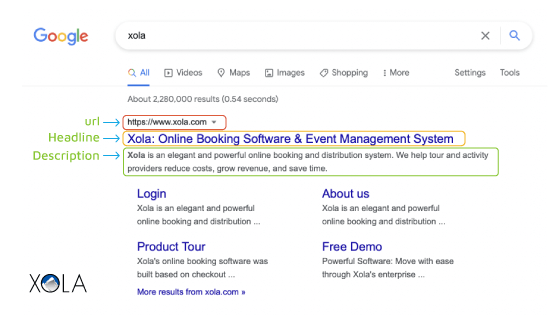
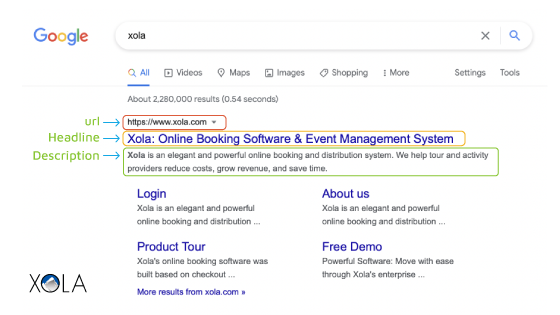
Wouldn’t it be nice to be able to reach guests who are specifically searching for tours and activities in your city? With paid search ads for tours, you can do just that.
Google Ads, or paid search ads, allows your tour company to be found at the right place at the right time. That is, on the front page of Google right when your guests are searching for experiences in your city.
The greatest advantage of investing in paid search ads is being able to market your tours and activities to people who are actively seeking them and are therefore more likely to book them.
Over 50% of all traffic for travel and tourism websites comes from search engines. Social media, on the other hand, brings in only a fraction of that. If you’re only investing in Facebook marketing, it’s time to start focusing on search engines, too.
Google Ads can take many different forms, including text search ads, visual display ads, and video ads on YouTube.
Are you a kayak tour operator in Florida? You can make your company visible to everyone who searches for “kayak tours in Florida.”
Have an axe-throwing business in Mississippi? Display an ad to people searching for “axe throwing in Mississippi.”
You get the idea. If you’ve never set up a paid search ad for your tours, let us guide you through the process in this in-depth guide to Google Ads.
- Why and how to use Google Ads in the travel industry?
- Why is SEM Important for Travel Companies?
- What problems can Google Ads solve for your company?
- Where do paid search ads show up?
- What is the difference between search ads and display ads?
- How can I run a paid search campaign?
- How do I write a paid search ad?
- Can you target Google ads by location?
- Best practices for responsive search ads
- How can I monitor my responsive search ads’ performance?
- Google Ad campaign examples
Why and how to use Google Ads in the travel industry?
Why should you use paid search ads for your tours? Because Google Ads lets you promote your tours to the right people, in the right place, and at the right time.
You can use Google Ads to appear on the first page of search results for keywords relevant to your tours or activities. This increases the chances that travelers will find and click on your website.
If you’ve experimented with search engine marketing (SEM) in the past then you know that virtually no one will see your website unless it’s on the first page of Google. That’s because less than 1% of people click on results on the second page.
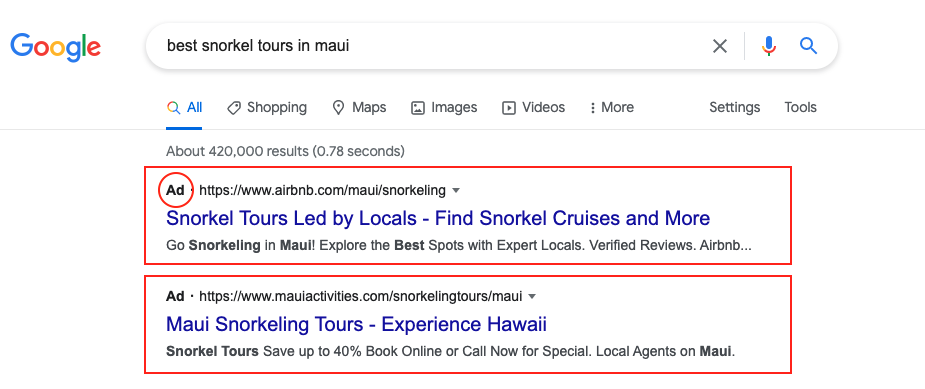
Let’s say you’re a snorkel tour operator in Maui. You can target the keywords “best snorkel tours in Maui” so that every time someone searches for that, your website comes up.
As you can see in the example above, Airbnb and Maui Activities are the first websites that pop up for this search. Google clearly identifies both as ads, but when you click on them, the experience is the same as clicking on any other website on the page.
Why is SEM important for travel companies?
SEM is one of the most valuable sources of website traffic for travel companies.
You don’t want to attract just any traveler to your website. You want to attract travelers ready to book.
Google Ads make your travel website visible to travelers interested in experiences in your destination. You’re specifically targeting people who are actively looking to book a tour or activity — meaning they’re likelier to hit that “book now” button than a passive browser.
It is possible to organically rank on the first page of Google through search engine optimization (SEO).
If you’ve dabbled with SEO in the past, you know that it can take months for your website to rank. Even if you’re pumping out tons of relevant blog content, it’ll take some time for a new website to rank.
With ads, you can instantly increase your website’s search engine visibility.
What problems can Google Ads solve for your company?
Investing in paid search ads can bring you a slew of benefits, including:
- Increase website visibility: Less than 1% of people click on the second page of Google. With SEM, you’ll make sure your site is seen on search engines.
- Instant ranking: It can take months or even years to organically rank on the first page of Google through traditional SEO practices. Paid search ads will get you instant visibility while you work on your long-term SEO strategy.
- Target the right audience: Your ads will be geared toward an audience that’s ready to book.
- Reach customers before your competitors: You know your customers are researching your trips on Google. Your ads can reach them before anyone else does.
Where do paid search ads show up?
Your Google Ads can appear in a few different places.

You’re probably most familiar with text ads on the first page of Google. These are known as “search ads” and can appear above or below search results for keywords you’ve chosen.
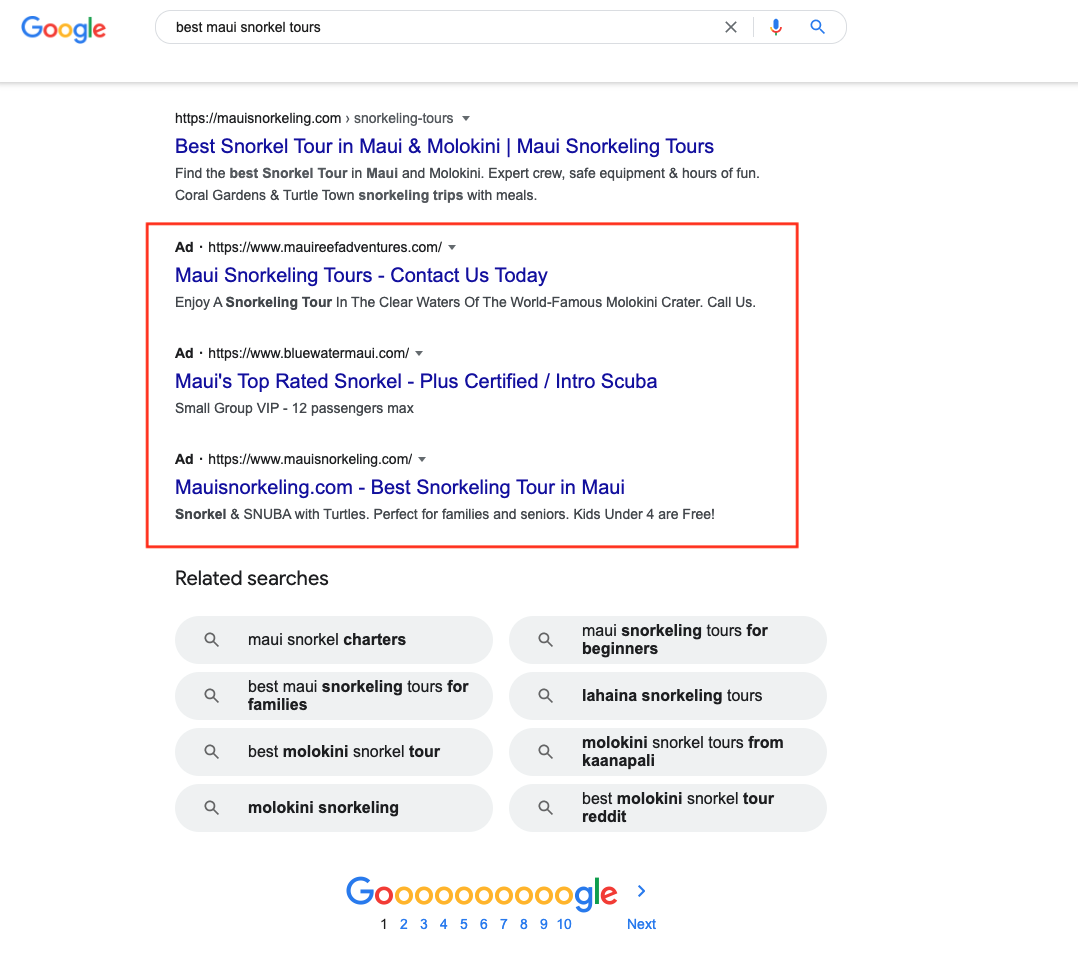
Search ads can also appear beside, above, or below search results on Google Play, in the Shopping tab, and Google Maps. Additionally, your text ad can also show up in search results on Google’s partner websites.
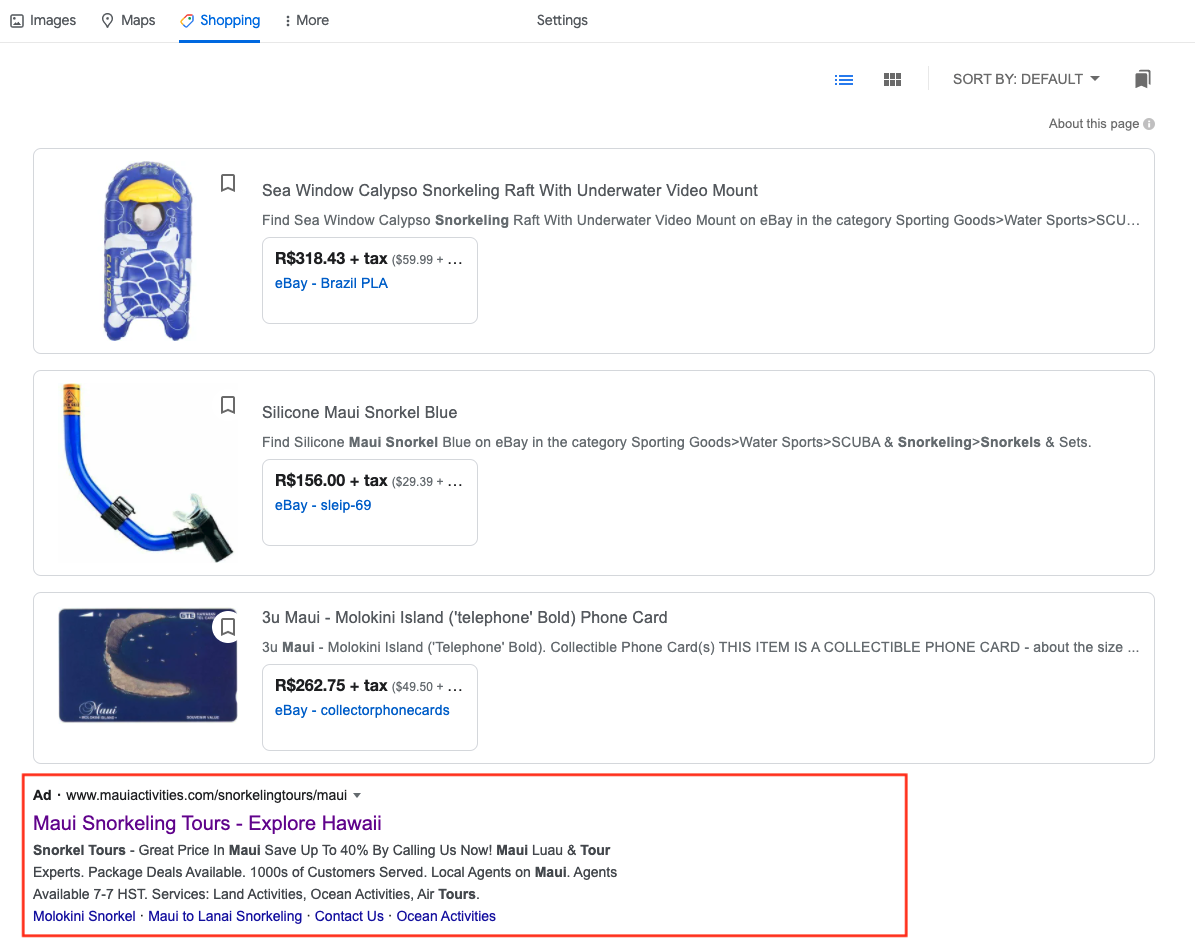
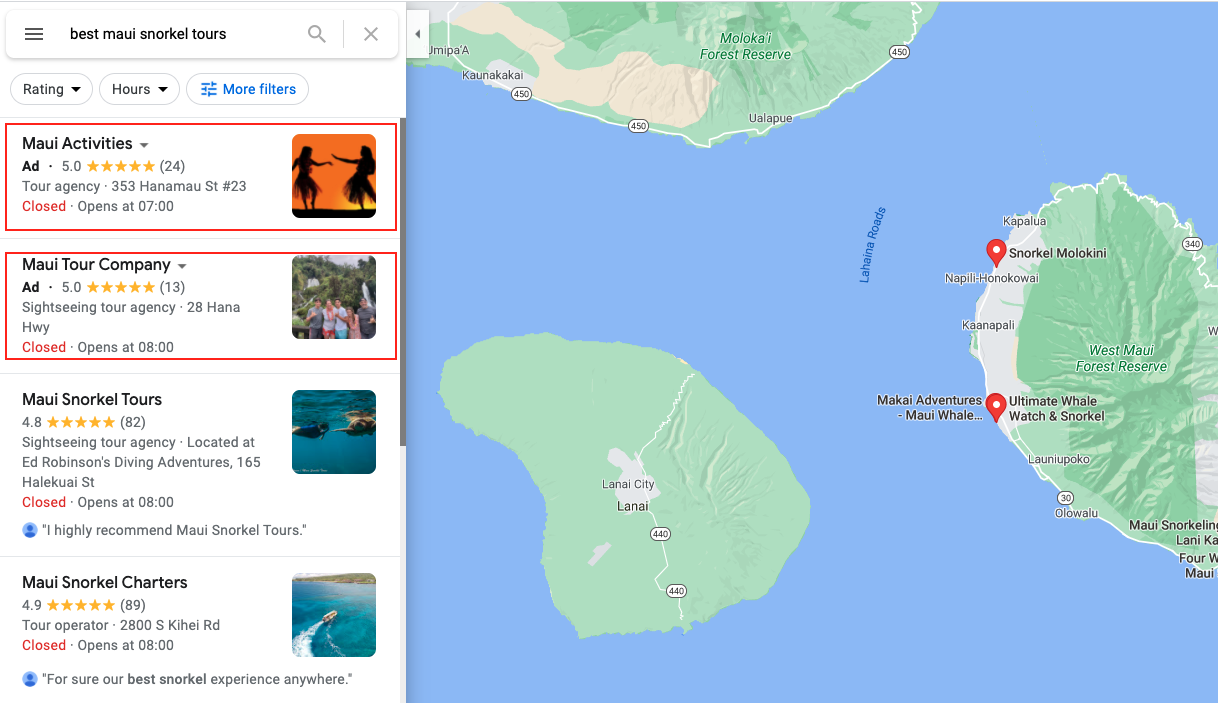
You can also have visual advertisements like banners appear on thousands of websites that are part of the Google Display Network. These are known as “display ads.”
What is the difference between search ads and display ads?

You can use both search ads and display ads to promote your tours across Google’s advertising networks. Google has two networks where your ads will be shown:
- Google Search Network: Your text ads are shown in search results and Google’s partner websites
- Google Display Network: Your visual ads (like banners) are shown on different websites your customers visit
Search ads allow you to put your tours and activities at the fingertips of guests who are searching for them. You can also target tourists searching for similar experiences in your destination.
This ad format leads to more conversions than display ads. The latter is shown to guests who aren’t actively searching for your tours. They’re shown to people who are browsing the web for other reasons.

Display ads, then, are better at introducing your brand to customers rather than converting them. While companies continue allocating ad spend toward display advertising, their effectiveness is waning.
Search ads offer customers the exact service they’re looking for, making them a much more effective advertising method.
How can I run a paid search campaign?
Ready to create your first paid search campaign?
First, you’ll need to create a Google Ads account if you don’t have one already. If you’re creating a new one, you’ll be prompted to start your new campaign. If you’re logging in to an existing account, click “Campaigns” on the menu on the left.
Step 1: Set your goal
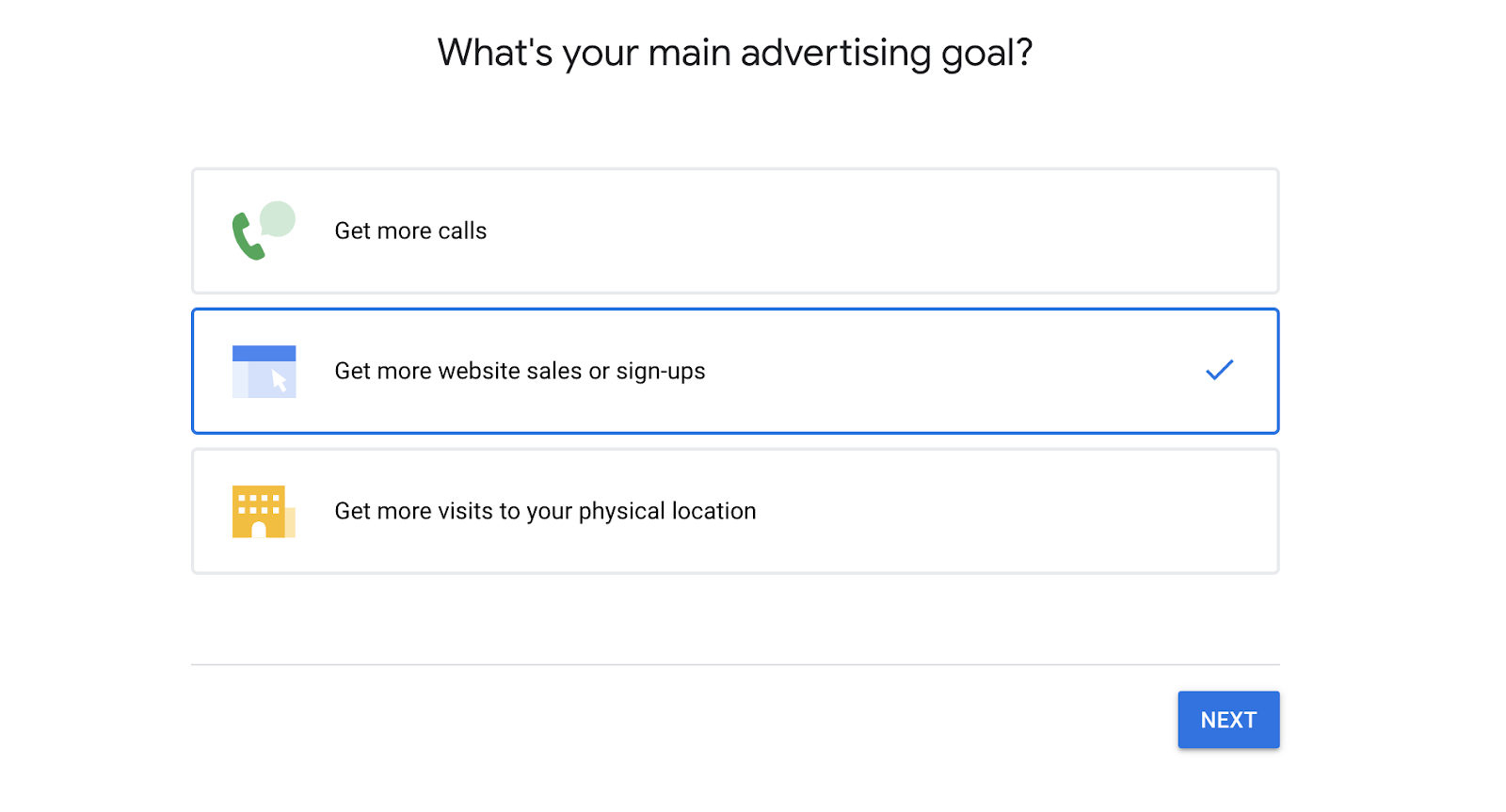
Select the goal that makes the most sense for your tour website — such as “get more website sales.”
Step 2: Select a campaign type
Next, you’ll be presented with the best campaign types for the goal you chose. Here are a few of the different campaign types available. Click on each to learn more about them.
- Search: Text ads on search results
- Display: Image ads on websites
- Video: Video ads on YouTube
- Discovery: Advertise within online feeds
Choose a search campaign and follow the next steps to set it up.
Step 3: Set up your audience targeting
Next, you’ll define your campaign settings. First up is audience targeting.
Google recommends thinking about the type of people who are ready to purchase your tours. Tour operators might target people traveling to or already visiting your city, for example.
Check the box for “Include Google search partners” for your ads to appear on additional search engines beyond Google. Check the “Display Network” box to show your ads beyond search results on other websites.
In the geographic targeting section, you can target people in a specific country, areas within a country, or a radius around a location. You can also exclude specific states or cities. You can further narrow down your location targeting to people who are searching for your targeted locations to reach guests traveling to your city.
Next, choose the languages you want to target.
Aside from geographic location, you can also target your audience based on the following criteria:
- What your guests are passionate about, their habits, and their interests.
- Demographics like age, gender, location, etc.
- Their recent purchase intent.
- Guests who have previously interacted with your business.
- Your existing customers based on CRM data.
- People with similar interests to existing customers.
Step 4: Set your budget & bidding
Your budget determines how many people see your ad. Decide how much you want to spend each day on average, and set that amount as your “daily budget.”
Next, you’ll choose your bidding, which will determine what you want people to do after seeing your ad. If you to drive more bookings, for example, you’d focus on “conversions.” For more website traffic, you’d choose “clicks.”
Most businesses focus on clicks, impressions, or conversions.
Tip: If this is your first time creating a search ad, Google recommends sticking to an average daily budget of $10 to $50.
Step 5: Set up ad groups & keywords
Now you’ll create groups of ads relevant to what people interested in your tours are searching online.
The default ad group is the standard one, where you’ll choose the keywords that you want your ads to appear under.
If you choose a keyword like “tours in Maui,” by default it’ll match a broad set of related searches. You can further narrow down these settings such as specifying exact phrases or excluding specific searches.
You can create as many ad groups as needed for your campaign.
Step 6: Finalize your search ad
Now follow the steps to create and finalize your ad:
- Enter the URL your ad to link to
- Write 1-3 headlines
- Write a description
Find out how to add tracking parameters to your URL to see where your traffic is coming from here.
Google will list any issues that could interfere with your ad results, and once it’s good to go, you can hit “Publish.”
How do I write a paid search ad?

Every search ad will have a headline, URL, and search description.
Your ad copy should focus on solving the viewer’s questions or needs. Both your headline and description should be relevant to your keywords and match what the user is searching for. Include your keywords in your ad text, and make sure your call-to-action is clear.
- Headline: Up to 3 headlines. 30 characters each. (No. 1 + 1a in the example above)
- Description: Up to 2 descriptions. 90 characters each. (No. 2)
- Site Link Extension: Aim for 4 extensions. 25 characters each. (No. 3)
You should also consider adding “extensions” — additional callouts or site links — to get more clicks. Extensions let you link to other pages of your site, such as specific tour packages, at the bottom of your ad. Google suggests adding at least 4 for each campaign or ad group.
Can you target Google ads by location?
Google’s geographic location targeting allows you to specify what countries, states, and cities you want your ads shown in. You can narrow it down even further by choosing a radius around a specific location or place of interest.
Radius targeting (or proximity targeting) is best for businesses aiming to reach people in specific regions, such as tour operators targeting people in their city. You can also target multiple locations at once.
You also have the option to target people searching for your targeted locations.
Google’s performance data features let you see where your ads are appearing and how well they’re performing in different locations.
Best practices for responsive search ads
A responsive search ad adapts to a user’s search intent and shows them the ad text that’s most relevant for them. You’ll create multiple headlines and descriptions and Google will test out over time.
Here are six tips for your responsive search ads:
1. Add as many relevant headlines and descriptions as you can
Provide about eight to 10 unique headline options so that Google can play around with different combinations and increase your ad performance. You should include your keyword in at least two of those headlines, as well as create three headlines that don’t have tour keywords.
Include at least two descriptions that highlight additional information about your tours. Responsive search ads can show up to two descriptions at a time.
Pro Tip: You can use AI copy generators — like Copy.ai — to get ideas and inspiration for your ad copy.
2. Reuse existing content from other ads
Look at your high-performing text ads and pull from those headlines and descriptions for your responsive ads.
3. Use Google Keyword Planner
Google Keyword Planner is a free tool that helps you research the best keywords for your ad. You can use to find search terms related to your business and view their search volume and targeting costs.
You can also organize keywords into different categories, making it easy to come back and choose new ones for later ads.
Tip: Your account needs to be on “expert mode” to access Keyword Planner.
4. Improve ad strength
Google provides you with feedback on the strength of your ad. Take a look at the tips provided to get your ad to “Good” or “Excellent” status before hitting publish.
5. Test only one responsive search ad per ad group
Google is testing different elements of your responsive search ads against one another, which means you only need to have one of them per ad group.
6. Create a negative keywords list
Define the “negative keywords” to exclude from your campaigns. You can tell Google to ignore specific search terms from your campaigns, such as similar keywords that match different search intent.
How can I monitor my responsive search ads’ performance?
Three of the most popular metrics to measure your search ads’ performance include return on advertising spend, cost per conversion, and conversion rate. Let’s break down these three metrics and others a bit further.
- Return on advertising spend: What’s your return on investment? This is the money spent on ads compared to the revenue you’ve generated from those ads.
- Cost per conversion: This is the amount you’re spending to get your ad viewers to take the desired action, like visit your website or book a tour.
- Conversion rate: The rate at which users are converting — booking a tour — after clicking on your ad.
- Click-through rate: How many people saw your ad and clicked through to the landing page.
- Cost per click: This is how much you’re paying per click-through to your site.
- Quality score: A 1-10 ranking of the quality of your keywords.
- Impression share: How many times your ads are showing compared to how often they could have been shown if they were ranking better or if your budget was larger.
You can easily track these metrics by syncing your Google Ads and Google Analytics accounts.
To link them, signed into your Google Analytics account, click “Admin,” and identify the property you want to link. In the “Property” column, click on “Google Ads Linking” and select the account you want to link.
Turn linking to “On.” Now you can track the full guest buying journey — from click on your ad to booking your tours.
Now that you know how to set up your first paid search campaign, it’s time to get to work. Google Ads allow you to target an audience too valuable to pass up.
Google Ad Campaign Examples
Here are a handful of relevant paid search and display ad examples.
Create video ads for Youtube

When Airbnb launched Airbnb Adventures, the home-sharing marketplace generated awareness with video ads on YouTube.
Airbnb Adventures allows travelers to “ditch the tourist trails” and explore a destination more uniquely. The campaign used video ad sequencing — including a short teaser, quick bumpers, and a long-form travel video — to tell a story about their new “adventures.”
The company wanted to promote the experience several times with different ads to show that the offering is different than its other experiences. The ads targeted travelers and adventure-seekers specifically, who would be interested in learning more.
By using storytelling techniques to appeal to a target audience, the campaign received nearly 8 million impressions on YouTube and conversion rates 40 times higher than the overall average for the Airbnb account.
Reach new customers on smartphones
According to this Think With Google case study, German tour operator Berge & Meer wanted to reach new customer groups and better understand how their guests were researching and booking trips using mobile — all while using its Google Ads budget efficiently.
Berge & Meer improved its Google Ads performance by adopting a data-driven model: Google used data to determine which keywords had the greatest impact on the tour operator’s goals so that Berge & Meer could adjust its bidding strategy.
For example, Berge & Meer was mainly investing in search ads that were clicked on right before a customer made a booking — but ignoring the previous ads that may have influenced them before that.
The company switched from a last-click attribution to a data-driven attribution model, which allowed it to optimize its bidding based on how customers were interacting with all ads along their buying journey.
As a result, bookings increased 24% over two months, while cost per acquisition (CPA) decreased by 15%.
Engage in surround sound marketing
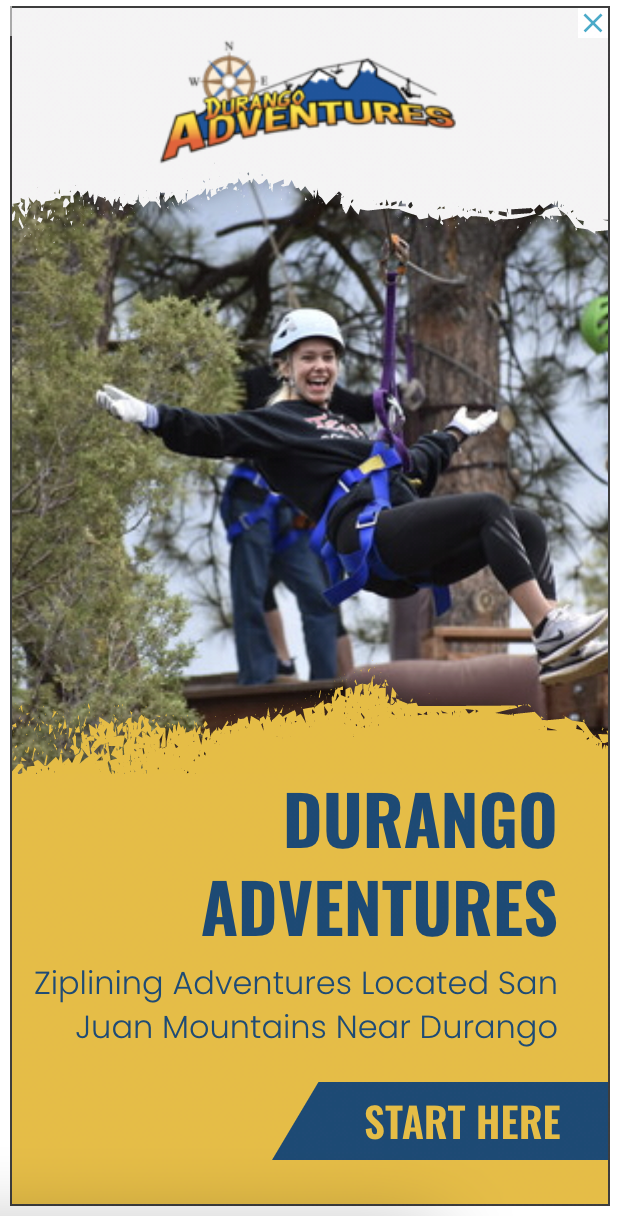
Colorado-based Durango Adventures uses dynamic display ads to promote its zipline tours across websites visited by potential customers.
The adventure tourism company has created visually eye-catching ads featuring video, special effects, and great outdoor photography. These elements help draw more eyes to an ad when it appears on the sidebar of a webpage.
Display ads can be shown as banners across Google’s Display Network, which includes over 2 million websites that reach over 90% of people on the internet.
Promote your tours around related searches

Eyjatours runs sightseeing tours in Iceland featuring volcanos and puffin sightings.
The tour operator is using search ads to promote its tours to travelers seeking similar experiences in Iceland. For example, when someone searches for “Iceland hiking tours,” Eyjatours’ ad appears in the search results.
If you take a closer look, you’ll find that the tour operator’s offering stands out from others because of its playful headline: Meet the Puffin Whisperer. It’s a creative way to pique traveler’s interests, especially since puffins are a big wildlife attraction in Iceland.
Even if the viewer wasn’t specifically searching for ways to see puffins in Iceland, after seeing this headline, they might be intrigued to click it.
Launch targeted search ads by location

St Pete Kayaking offers kayaking tours in the St. Petersburg, Florida region. The ad example above shows that the tour operator is using geographic location targeting to reach people searching for activities in Tampa, a city that sits right across the bay.
The business excellently highlights what’s unique about their tours — see-through kayaks — in the ad headline and description. You’ll also see that the keywords “kayak” and “kayaking” are present in both.
The ad also does a great job informing customers about relevant tour logistics in just a few words: It’s a guided and narrated tour that’s great for beginners. Finally, a clear call to action is also present.
Reach millennial travelers
Group tour operator Intrepid Travel launched a video ad campaign reach its target demographic of 25- to 40-year-old travelers.
Intrepid wanted to generate brand awareness, as well as increase direct website traffic and conversions from its Google Ads. Intrepid turned was at first focusing on paid search ads, but then turned to YouTube — knowing that two-thirds of consumers watch online travel videos when thinking about taking a trip.
The company’s “Beyond Borders” campaign targeted select cities in Europe with short bumper ads and longer in-stream video ads, which resulted in 12 million impressions, 2.4 million views on its YouTube channel, and increased revenue in key cities.
Launch dynamic banner ads
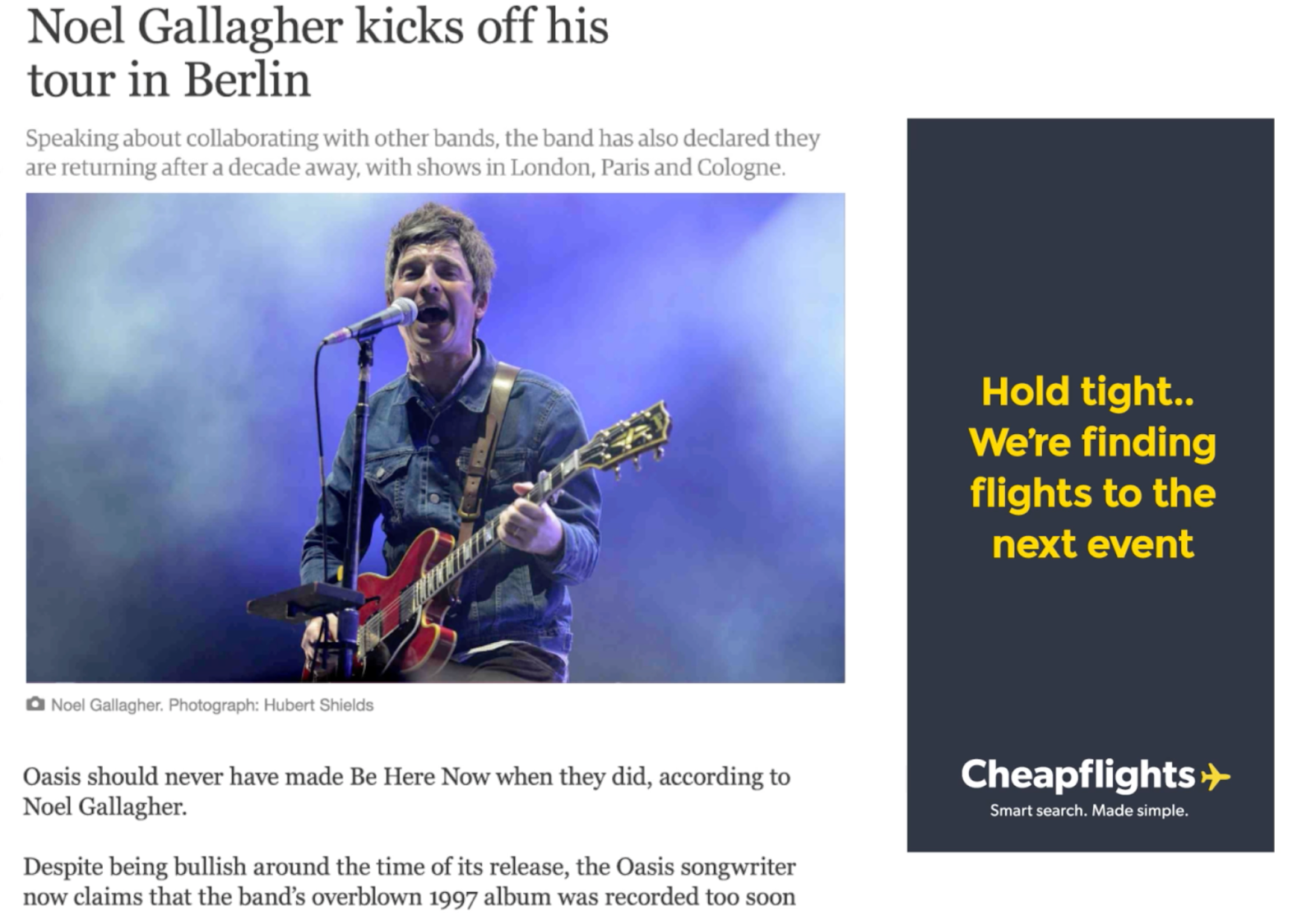
Cheapflights created a unique ad banner that adapted to what users were searching for on the internet.
The ad appeared in different articles across the internet about sports, art, and music events. Readers could then drag and drop the article image onto the Cheapflights banner, and the flight search engine would instantly find the best tickets to the destination where that event was taking place.
Cheapflights turned its display into a simple flight search. It was a genius way to offer its services directly to people who were researching experiences in different destinations.
The campaign resulted in 145% more engagement, 8.5% more web traffic, and a 16.5% increase in annual revenue.
What can we take away from these Google Ad examples?
Knowing your audience is key. These ads work because they appeal to a specific group of people. The travel companies have studied their customers and know what Google searches or YouTube videos they’ll be looking up before a trip.
Now it’s your turn to experiment with Google Ads and meet your customers where they’re searching for you.




